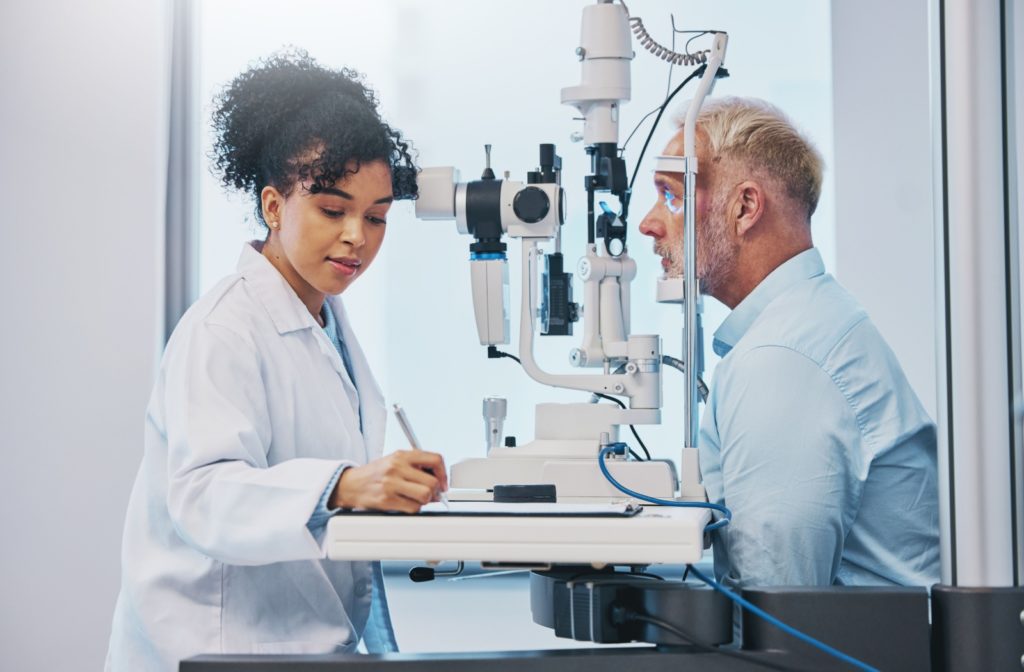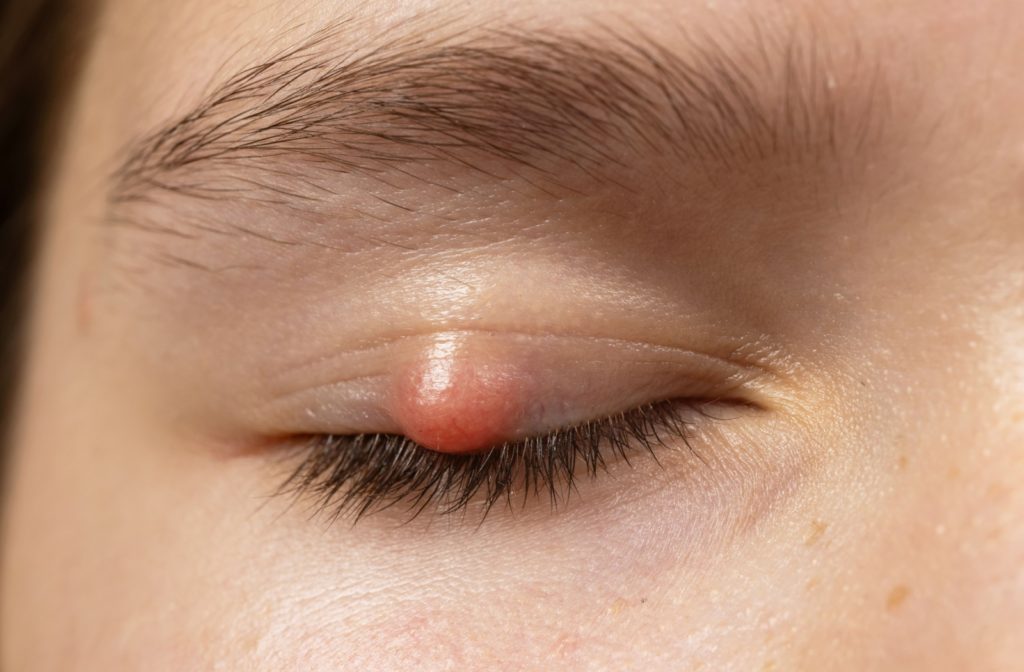If you’ve recently noticed a small bump on your eyelid, you might be dealing with a chalazion. While not typically painful, these lumps can be concerning and uncomfortable.
A chalazion typically lasts anywhere from a few weeks to several months, depending on the severity. Proper diagnosis and treatment can help clear up the chalazion.
If you’re unsure what that small bump is, however, your optometrist can examine it and help you find a solution. Chalazia are frequently confused with styes, so staying informed is one of the best ways to know exactly what you’re dealing with.
What Is a Chalazion?
A chalazion is a typically painless red bump that appears on your eyelid. It can start quite tender but may progress into a bigger lump. These lumps result when the meibomian glands, responsible for oil production, become clogged.
You may be more likely to get a chalazion if you have one of these conditions:
- Rosacea
- Blepharitis
- Seborrhea
- Tuberculosis
- A viral infection
While a chalazion might sound alarming, it’s a common eye condition.
Chalazia are often confused with a stye. However, unlike a stye, which is typically painful and occurs at the edge of the eyelid, a chalazion forms further back and tends to grow slowly over time. Styes are bacterial infections, but chalazia are inflammatory and typically not infectious.
Recognizing the difference between a chalazion and a stye is essential because they require different treatments.
Chalazion Symptoms & Diagnosis
A chalazion typically appears as swollen lumps on the eyelid, often without the pain associated with other eye conditions. It’s more common to have a chalazion on the upper eyelid, but it can also form on the bottom eyelid. You might notice redness and tenderness initially, though these symptoms usually diminish as the chalazion develops. In some cases, larger chalazia can press against the eyeball, causing blurred vision.
Diagnosing a chalazion involves a simple examination by your optometrist. We can assess the lump’s appearance and location, ruling out other potential causes. Typically, no invasive tests are required.
Most chalazia resolve on their own within a few weeks to a month. However, several factors can influence this duration, including the chalazion’s size and your overall eye health. Larger chalazions or those not responding to home remedies might require medical attention to prevent further issues.
If a chalazion persists beyond the typical duration or causes significant discomfort, contact your eye doctor immediately. We can assess if an underlying condition requires attention and provide appropriate treatments if needed.

How to Treat a Chalazion
Treating a chalazion often starts with home remedies. Your doctor can recommend effective treatments during your eye exam, but there are a few common methods. Whatever treatment you use, remember to always wash your hands before touching your eye area.
Applying warm compresses several times a day for around 10 minutes can help reduce swelling and promote drainage by loosening blocked oils in the gland. Follow these steps to make your own warm compress:
- Gather your supplies: You’ll need a clean cloth, a bowl of warm (not boiling) water, and a towel. For convenience, you can opt for a microwave-safe heating pad or gel pack.
- Soak the cloth: Dip the clean cloth into the warm water, allowing it to soak up heat until fully saturated.
- Wring out excess water: Carefully wring the cloth to remove excess water, ensuring it’s warm and damp but not dripping.
- Apply the compress: Whether you’re using a cloth, a gel pack, or a heating pad, close your eye and place the warm compress directly over the affected eyelid.
It’s important not to squeeze the chalazion as this can cause more damage. Though pain is not commonly associated with chalazia, over-the-counter pain relievers might relieve some discomfort.
If home treatments prove ineffective, medical interventions include steroid injections to reduce inflammation or minor surgical procedures to drain the chalazion. Each treatment option has pros and cons, so consult your eye doctor for advice tailored to your situation.
How to Prevent a Chalazion
Preventing chalazia involves maintaining good eyelid hygiene. Regularly clean your eyelids with mild soap and water to help reduce the risk of gland blockages and remove all eye makeup completely before going to bed. Additionally, wash your hands before touching your eyes, especially if you’re putting in or taking out contact lenses.
If you’re recovering from a chalazion, continue practicing good hygiene to prevent the chalazion from reappearing. You should adhere to any specific instructions from your optometrist. Regular eye exams can also monitor your meibomian glands and play a vital role in maintaining overall eye health!
Taking proactive steps not only prevents chalazia but also promotes healthier eyes. Make eyecare a routine part of your lifestyle.
Comprehensive Eye Care Starts Here
While they can be troublesome—and shocking to see first thing in the morning—most chalazia can be resolved with regular home treatments.
If you’re dealing with a persistent chalazion or simply need some expert advice, don’t hesitate to consult with the eye care professionals at Total Vision Solana Beach! We offer a personalized approach that can make all the difference in preserving your eye comfort.Take the next step and book your appointment today!



